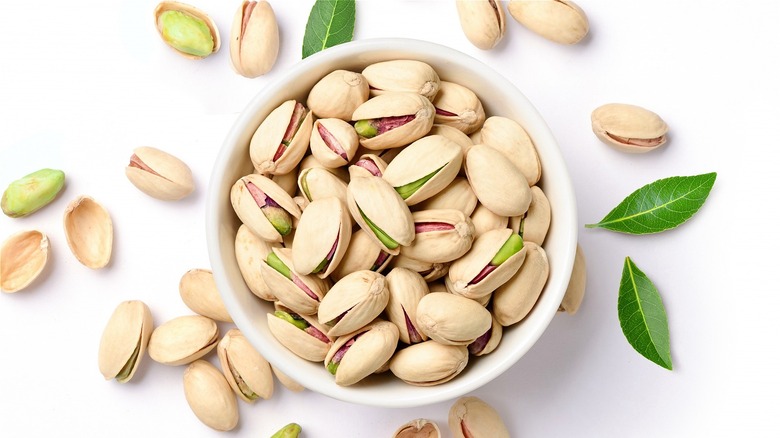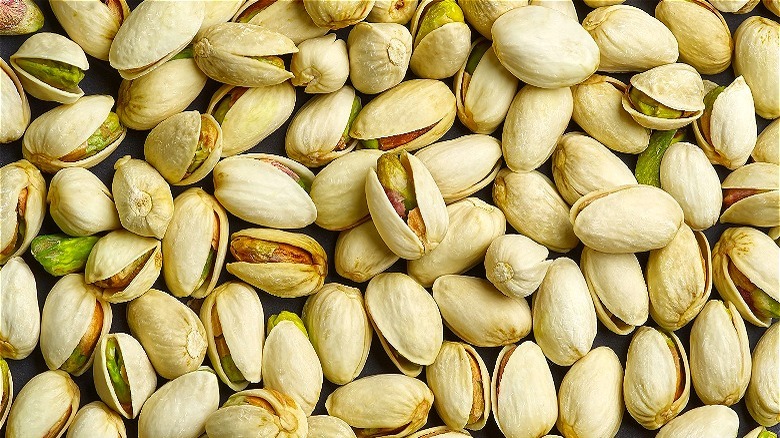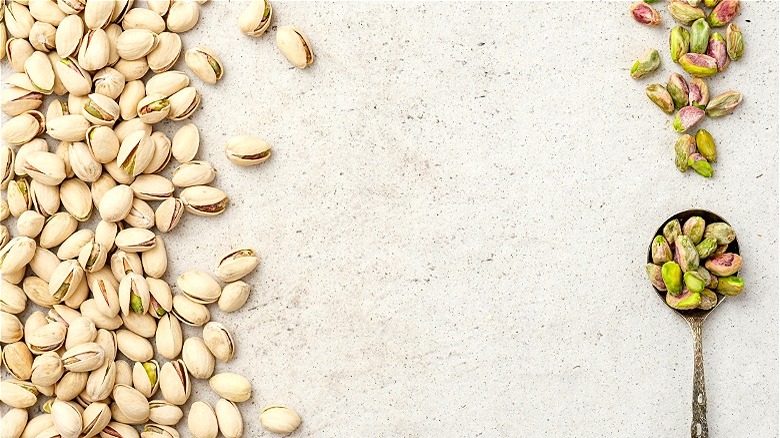Why Pistachios Are Often Sold In Their Shells
Pistachios are reportedly among the 10 best nuts for your health, though Specialty Produce claims those little green nutmeats are actually seeds that grow on trees within the cashew family. Beyond their year-round availability, the best parts of consuming pistachios are probably their unique taste and the health benefits they provide. According to Cleveland Clinic, pistachios contain several antioxidants and a healthy dose of vitamin B6, in addition to being a solid source of unsaturated fats. American Pistachio Growers also lists numerous studies linking the positive effects of pistachios to heart health.
Aside from being a healthy everyday snack, the popularity of pistachio-flavored foods has grown substantially in the last decade. In its "Pistachio Flavor Insight Report," flavor manufacturer FONA claims 34% more pistachio-flavored products were developed worldwide between 2016 and 2021. Along with the increasing popularity of these green kernels as a flavor enhancer and heart-healthy snack option, there is one element that sets pistachios apart from other nuts and seeds: They are sold both in and out of shells. Interestingly enough, there is more than one reason pistachio suppliers keep these colorful seeds in their coverings, from a marketing and convenience standpoint.
In-shell pistachios: more efficient for manufacturers and healthier for consumers
According to Ask Nature, Brazil nuts, macadamia nuts, and coconuts are among the hardest nuts to crack, but the ripening split that naturally occurs in pistachios makes opening them fairly easy to accomplish by hand. And from a production standpoint, co-author of "Pistachio Production Manual" Louise Ferguson explains to How Stuff Works that once the seeds have been harvested by growers, the roasting process penetrates the inner nutmeat through the natural crack that forms in the majority of pistachios, which ultimately saves processors extra time and money they would have otherwise spent de-shelling.
While you can buy pistachios with or without their shells, there is a surprisingly large market for in-shell pistachios due to their marketably fun and conscientious consumption process. Vice President for The Wonderful Company Adam Cooper told Produce Business that "the act of shelling, which may be considered playing with food, makes pistachios the mindful nut." And he may be right: In one 2011 study in Appetite, researchers found individuals who ate in-shell pistachios consumed fewer calories than those who ate the shelled version.
In-shell and shelled pistachios are both popular among consumers, but is there a benefit to buying one over the other? While the in-shell variety has been noted as a healthy weight-management snack option, bare pistachios are great to have on hand to toss on a salad or use in a variety of desserts like vanilla white chocolate pistachio fudge. However, there may be unlikely differences between the two varieties that you wouldn't expect.
Convenience and cost matter when buying pistachios
Whether you routinely worry about storing groceries wrong or not, it's natural to wonder if there's a decrease in shelf life for out-of-shell pistachios compared to their intact counterparts. Fortunately, the University of California claims both varieties last as long as one year when stored in proper temperatures — and up to three years when frozen.
Now that you don't have to worry about longevity disparities, convenience and cost are still major factors when deciding which variety fits better into your lifestyle. According to the National Agricultural Statistical Service (NASS), as reported by the Agricultural Marketing Resource Center, in 2020 over 4.5 times more shelled pistachios were sold than those in shells. Not only are pistachio lovers enjoying the convenience of the naked seeds, but they may actually be cheaper when you factor in edibility and time.
The Washington Post conducted a cost-benefit analysis of both varieties in 2018 comparing not only the number of seeds present after removing shells but also the "labor cost" of in-shell pistachios (which appear on the surface to be the cheaper choice). Not only did the shell-free pistachios prove to be just as cost-effective as in-shell pistachios in terms of final edible product, but not having to shell those tasty morsels saves loads of valuable time for the consumer over multiple snacking sessions. If you do decide to continue buying in-shell pistachios, though, instead of using your nails or teeth to crack open those ornery few in every bag, try Wonderful Pistachios' tried-and-true tool of choice to assist you: an upcycled pistachio shell.


